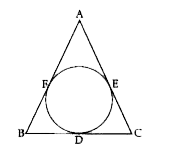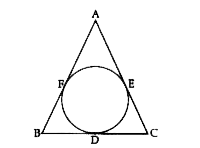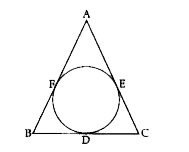Suresh's field is in the shape of a trapezium, whose map is in the scale 1 cm = 20 m. He want to draw four divisons in his field, so he could grow four different drops. The field is divided into four parts by joining the opposite vertices

Triangles AOB and COD are:
similar by SAS criteria
similar by RHS criteria
similar by AA criteria
not similar
Step by step video & image solution for Suresh's field is in the shape of a trapezium, whose map is in the scale 1 cm = 20 m. He want to draw four divisons in his field, so he could grow four different drops. The field is divided into four parts by joining the opposite vertices Triangles AOB and COD are: by Maths experts to help you in doubts & scoring excellent marks in Class 10 exams.
Updated on:21/07/2023Topper's Solved these Questions
- SAMPLE PAPER 11 (SELF - ASSESSMENT)BOOK - EDUCART PUBLICATIONCHAPTER - SAMPLE PAPER 11 (SELF - ASSESSMENT)EXERCISE - SECTION -B
13 Videos
- SAMPLE PAPER 11BOOK - EDUCART PUBLICATIONCHAPTER - SAMPLE PAPER 11EXERCISE - PART -B (SECTION-V)
4 Videos
- SAMPLE PAPER 13BOOK - EDUCART PUBLICATIONCHAPTER - SAMPLE PAPER 13EXERCISE - PART - B (SECTION - V)
4 Videos
Similar Questions
Kamla has a triangular field with sides 240 m, 200 m, 360 m, where shegrew wheat. In another triangular field with sides 240 m, 320 m, 400 m adjacent to the previous field, she wanted to grow potatoes and onions. She divided the field in two parts by joining the mid point of the longest side to the opposite vertex and grew potatoes in one part and onions in one part. How much area (in hectares) has been used for wheat,potatoes and onions? ( 1 hectare = 10000 m2 )
View SolutionKamla has a triangular field with sides 240m,200m,360m, where she grew wheat. In another triangular field with sides 240m,320m,400m, adjacent to the previous field, she wanted to grow potatoes and onions as shown in figure. She divided the field in two parts by joining the mid-point of the longest side to the opposite vertex and grew potatoes in one part and onions in the other part. How much area (in hectares) has been used for wheat, potatoes and onions ? (1hectare=10000 m2)
View Solution
Knowledge Check
In the following questions, you have two brief passages with 5 questions following each passage. Read the passages carefully and choose the best answer to each question out of the four alternatives.
Two years later, in November 1895, he signed his final will. He left the bulk of his fortune, amounting to about £ 1,75,000 to a trust fund administered by Swedish and Norwegian trustees. The annual interest shall be awarded as prizes to those persons who during the previous year have rendered the greatest services to mankind. The interest shall be divided into five equal parts - now amounting to about £ 8,000 each - one of which shall be awarded to the person who has made the most important discovery or invention in the realm of physics, one to the person who has made the most important chemical discovery or improvement, one to the person who has made the most important physiological or medical discovery, one to the person who has produced the most outstandIng work of literature, idealistic in character, and one to the person who has done the best work for the brotherhood of nations, the abolition or reduction of standing armies, as well as for the formation or popularization of peace congress.
The number of prizes in the field of science areAFourBOneCThreeDFiveIn the following questions, there are six parts marked S1, S6, P, Q, R and S. The position of S1 and S6 are fixed. Some parts of the sentence have been jumbled up. Rearrange these parts and choose the proper sequence from the given options. In some of the questions, a sentence is divided into four parts (P, Q, Rand S). Rearrange it in the proper sequence in order to make a meaningful sentence.
S1. Once when a lion, the king of the jungle, was asleep, a little mouse began running up and down on him.
P. This soon awakened the lion, who placed his huge paw on the mouse, and opened his big jaws to swallow him.
Q. I shall never repeat it and I shall never forget your kindness.
R. “Pardon, O King!” cried the little mouse.
S. “Forgive me this time and who knows, I may be able to do you a good turn one of these days!”
S6. The lion was so tickled by the idea of the mouse being able lo help him that he lifted his paw and let him go.APRQSBSQPRCQSPRDQPRS
In a four - sided field , the length of the longer diagonal is 120 m . The lengths of perpendicular from the opposite vertices on this diagonal are 20 m and 15 m .Find the area of the field .
View SolutionRead the following text and answer the following question on the basis of the same :
A farmer has a field in the shape of triangle with AB=13 cm, BC=14 cm and AE =7 cm .He wants to leave a space in the form of a circular field for growing wheat and the remaining for growing vegetables.

The measure of AF is :
View SolutionRead the following text and answer the following question on the basis of the same :
A farmer has a field in the shape of triangle with AB=13 cm, BC=14 cm and AE =7 cm .He wants to leave a space in the form of a circular field for growing wheat and the remaining for growing vegetables.

The measure of BF is :
View SolutionRead the following text and answer the following question on the basis of the same :
A farmer has a field in the shape of triangle with AB=13 cm, BC=14 cm and AE =7 cm .He wants to leave a space in the form of a circular field for growing wheat and the remaining for growing vegetables.

The measure of BD is :
View SolutionRead the following text and answer the following question on the basis of the same :
A farmer has a field in the shape of triangle with AB=13 cm, BC=14 cm and AE =7 cm .He wants to leave a space in the form of a circular field for growing wheat and the remaining for growing vegetables.

The measure of CE +CD is :
View SolutionPQRS is a square whose side is 20 cm. By joining opposite vertices of PQRS are get four triangles. What is the sum of the perimeters of the four triangles?
View Solution
